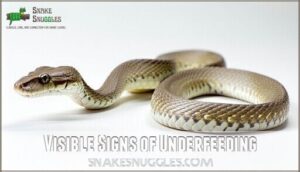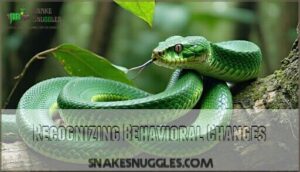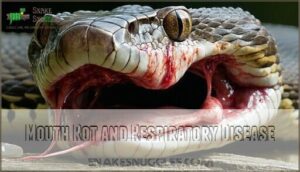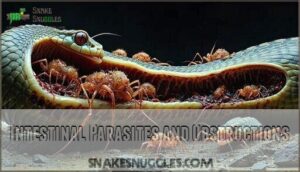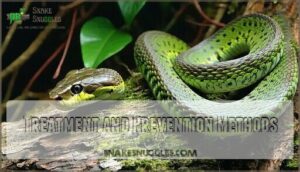This site is supported by our readers. We may earn a commission, at no cost to you, if you purchase through links.

First, check your temperatures and humidity levels, as incorrect conditions shut down their appetite. Examine your snake for signs of shedding, illness, or stress from recent changes.
Try warming prey to body temperature, offering different prey sizes, or switching between live and frozen options. Many healthy snakes fast seasonally or during breeding periods, sometimes for months.
However, if your snake shows signs of weight loss, lethargy, or other concerning symptoms alongside refusing food, it’s time for a vet visit. Most feeding strikes resolve with patience and proper troubleshooting techniques, and understanding that snakes may refuse food due to breeding periods.
Table Of Contents
- Key Takeaways
- Snake Eating Problems
- Why Snakes Refuse Food
- Snake Feeding Strategies
- Identifying Underfeeding Issues
- Normal Fasting Periods
- Snake Diseases and Parasites
- Treatment and Prevention Methods
- Veterinary Intervention Guidelines
- Natural Causes of Appetite Loss
- Frequently Asked Questions (FAQs)
- How do you stimulate a snake to eat?
- Why isn’t my snake coming out to eat?
- What to do when a snake isn’t eating?
- How can I encourage my snake to eat?
- How long can a snake go without eating?
- How to tell if a snake is starving?
- How can I tell if my snake is stressed?
- What signs indicate my snake is dehydrated?
- Can handling my snake affect its appetite?
- How do I safely relocate my snake’s enclosure?
- Conclusion
Key Takeaways
- Check your snake’s environment first – incorrect temperatures, humidity levels, or lack of proper hiding spots commonly cause feeding refusal
- Don’t panic about temporary fasting – healthy adult snakes can safely go months without eating during natural cycles like shedding, seasonal changes, or breeding periods
- Try warming prey to body temperature and enhancing scent with chicken broth or other attractants to stimulate your snake’s feeding response
- Monitor for concerning signs like visible ribs, sunken eyes, or lethargy alongside food refusal – these warrant immediate veterinary attention
Snake Eating Problems
When your snake refuses food, you’re likely dealing with one of several common issues that affect appetite.
Don’t panic when your snake skips dinner—appetite loss often signals natural behavior, not health emergencies.
Understanding whether the problem stems from environmental conditions, natural behavior patterns, or health concerns will help you determine the right solution to address the issue of your snake refusing food, which is often related to appetite.
Common Causes of Loss of Appetite
When your snake refuses food, stress factors like excessive handling or habitat changes often trigger the problem.
Molting period, seasonal fasts, and brumation state represent natural causes where snakes temporarily stop eating.
Pregnancy effects in females also reduce appetite substantially.
Understanding these snake wont eat reasons helps distinguish between normal behavior and potential snake illness.
Proper snake husbandry and recognizing stress indicators prevent many feeding issues before they become concerning health problems.
Environmental Factors Affecting Appetite
When your snake’s habitat feels more like a stress chamber than a sanctuary, appetite disappears fast. Temperature Gradients, Humidity Levels, and Lighting Cycles must align with species needs.
Key environmental factors affecting appetite:
- Enclosure Size extremes create anxiety and feeding refusal
- Poor Hiding Spots expose snakes to constant stress
- Incorrect temperature disrupts digestion and metabolism
- Wrong humidity causes dehydration and respiratory issues
Perfect habitat design reduces stress and improves husbandry success.
Health Conditions Causing Inappetence
While poor environmental conditions often trigger feeding refusal, illness may be the real culprit behind your snake not eating.
Infection symptoms like wheezing, mouth bubbles, or swollen gums signal serious snake health issues. Dehydration appears as dull skin or sunken eyes.
Metabolic disorders, parasites, and physical injuries also cause appetite loss. Parasite detection requires fecal testing, while respiratory infections need immediate attention.
Veterinary consultation becomes necessary when you spot these warning signs to prevent complications.
Why Snakes Refuse Food
Understanding why your snake refuses food helps you address the problem effectively. Multiple factors can trigger snake not eating behaviors, from environmental disruptions to natural biological processes.
Stress Reduction becomes necessary when handling changes or tank relocations upset your pet’s routine. Like moving to a new house, snakes need time to adjust to environmental shifts. Temperature fluctuations and humidity imbalances create additional anxiety that leads to snake appetite loss.
Natural cycles also cause snake feeding refusal causes. During Shedding Cycle periods, snakes often fast for days before and after molting. Brumation Periods trigger extended fasting as snakes enter their hibernation-like state. Female snakes experience Pregnancy Effects that reduce their interest in food.
Snake health issues present another category of concern:
- Respiratory infections cause wheezing and breathing difficulties
- Mouth rot creates painful eating conditions
- Parasites disrupt digestive processes.
Prey Preference matters too – wild-caught snakes may reject domestic rodents they don’t recognize. Observing these patterns helps identify whether you’re dealing with snake refusing food due to stress, health problems, or natural behaviors.
Snake Feeding Strategies
When your snake refuses food, specific presentation techniques can make all the difference in triggering their natural feeding response.
These proven strategies address common feeding challenges by making prey more appealing and accessible to reluctant eaters, using complete concepts and proven strategies.
Warm Prey Presentation
Temperature matters when your snake won’t eat. Cold prey signals "dead" to your snake’s heat-sensing organs, triggering refusal. Proper heating methods and temperature consistency guarantee successful snake feeding through effective prey presentation.
Follow these steps for ideal warming prey:
- Thaw frozen prey completely in warm water, never microwaving
- Heat to 100-105°F using consistent heating methods like warming lamps
- Test temperature on your wrist before offering
- Maintain prey freshness throughout the warming process
- Time presentation timing when your snake shows interest
This snake appetite stimulation technique mimics natural hunting conditions. Consider using specialized heat sources for optimal results. Your snake preference for warm prey stems from evolutionary hunting instincts that detect live, warm-blooded meals.
Enhancing Prey Scent
Adding aromatic enhancements can transform your reluctant snake into an enthusiastic eater. Scenting Techniques work by triggering your snake’s natural hunting instincts through smell.
When your snake wont eat standard prekilled prey, try these proven methods. Chicken Broth remains the most popular option—simply dab a small amount on frozenthawed prey before offering.
For stubborn feeders, Braining Rodents (exposing brain matter) creates an irresistible scent that mimics fresh kills. Lizard Scent works exceptionally well for species that naturally hunt reptiles. Many owners buy frozen reptile food online for convenience.
Scent Transfer involves rubbing prey items together or using bedding from live feeder enclosures. This technique makes frozen prey smell "alive" again.
Method How It Helps Tip Ease Time
Smart prey selection combined with these scenttransfer techniques often resolves feeding issues within days.
Offering Familiar Prey Types
If your snake won’t eat after scent enhancement, stick with familiar prey types.
Prey recognition depends heavily on dietary consistency – don’t switch from mice to rats when your snake’s already stressed.
Scent familiarity matters more than variety during feeding problems. Preferred prey that matches their previous diet prevents additional confusion.
Avoid switching prey types until normal eating resumes, as prey selection changes can worsen appetite issues in snakes already experiencing snake not eating situations.
Experimenting With Prey Colors
Color perception varies dramatically among snake species, making prey contrast a vital factor when your snake won’t eat.
You can experiment with different prey colors to stimulate snake appetite and improve hunting success through enhanced visual acuity.
- White prey stands out against dark substrates, catching their attention instantly
- Brown or natural tones mimic wild prey, triggering instinctive feeding responses
- Black prey creates stark contrast in lighter environments, enhancing visibility
- Grey options offer subtle variation that some species prefer over bright colors
- Pink prey can appear more lifelike, especially when properly warmed before presentation
Species variation affects color preferences substantially.
Some snakes respond better to high-contrast options, while others prefer natural earth tones.
Pay attention to your snake’s hunting behavior during prey presentation – you’ll notice increased interest when the right color combination clicks.
This snake feeding strategy often works when familiar prey types haven’t succeeded, giving you another effective tool for snake wont eat solutions.
Identifying Underfeeding Issues
When your snake refuses food for extended periods, you’ll need to distinguish between normal fasting and potential health concerns that require intervention.
Understanding the warning signs of underfeeding helps you determine whether your snake’s appetite loss is temporary or indicates a more serious underlying issue, such as underfeeding.
Visible Signs of Underfeeding
Several warning signs indicate your snake isn’t getting enough nutrition. Sunken eyes represent one of the most obvious red flags—healthy snakes have bright, alert-looking eyes that fill their sockets properly. When your snake’s not eating regularly, dehydration and muscle wasting create that hollow-eyed appearance.
Rib visibility and spinal prominence signal serious trouble. You shouldn’t see individual ribs or vertebrae outlined beneath your snake’s skin. These visible signs of underfeeding mean your pet has burned through its fat reserves and started consuming muscle tissue.
Lethargic behavior accompanies physical deterioration. A hungry snake moves sluggishly, lacks its usual alertness, and may struggle with basic movements. This weight monitoring becomes essential when your snake not eating extends beyond normal fasting periods.
Symptom What You See What It Means Action to Take
Monitoring Weight and Health
Weight Tracking serves as your snake’s health barometer, revealing critical patterns when your snake not eating becomes concerning.
Document weekly weights using a digital scale to spot gradual declines that signal visible signs of underfeeding.
Hydration Levels require attention—gently pinch loose skin; it should snap back immediately.
Examine Shedding Patterns for irregularities, as poor nutrition affects molting cycles.
Behavior Observation includes noting lethargy or unusual positioning.
Consider Fecal Analysis if droppings appear abnormal, as digestive issues often accompany feeding problems.
Consistent monitoring weight and health prevents minor issues from becoming serious snake health emergencies.
Recognizing Behavioral Changes
Beyond monitoring weight, behavioral changes reveal critical insights about your snake’s wellbeing.
Watch for shifts that signal stress or illness affecting appetite. Activity levels dropping suddenly often indicates problems. Hiding frequency increases when snakes feel vulnerable or unwell.
Notice if your snake stopped eating alongside these warning signs:
- Unusual aggression during handling or feeding attempts
- Regurgitation signs like undigested food reappearing
- Social interaction changes, avoiding normal exploration patterns
These behavioral changes help you catch issues before they worsen. Snake behavior speaks volumes about their health status.
Over-handling can trigger defensive snake behaviors, further complicating feeding.
Normal Fasting Periods
Before panicking about your snake’s refusal to eat, understand that extended fasting periods are completely normal behavior for most species.
Many snakes naturally fast for weeks or even months due to seasonal changes, breeding cycles, or simply because they’re not hungry yet, which is a result of their natural behavior and breeding cycles.
Species-Specific Fasting Durations
Python fasting periods vary dramatically by species.
Ball python preferences include months-long fasts, especially during breeding season.
Corn snake brumation can last 2-3 months in winter.
Green tree diet specialists may refuse food for weeks while adapting to captivity.
Egg-eater habits involve seasonal feeding cycles.
Understanding your snake species helps distinguish normal fasting from health concerns requiring intervention.
Notably, intestinal upregulation occurs in pythons post-feeding, which is a key aspect of their physiological response.
Metabolic Slowdown During Fasting
When your snake enters a fasting period, its body naturally triggers a metabolic slowdown—nature’s way of preserving energy during times of snake feeding refusal.
This biological response helps snakes survive seasonal fasts without compromising their health.
Here’s how metabolic slowdown affects your snake:
- Energy Conservation – Heart rate and cellular processes decrease substantially
- Reduced Digestion – Stomach acid production drops to minimal levels
- Organ Function – Kidneys and liver operate at reduced capacity
- Hormone Regulation – Growth and stress hormones adjust to fasting mode
This snake hunger strike isn’t cause for alarm—it’s an evolutionary adaptation that allows snakes to survive extended periods without food while maintaining essential bodily functions.
Lethargy and Extended Fasting
Extended fasting periods naturally lead to reduced Activity Levels in your snake. During Fasting Duration extending weeks or months, your pet enters conservation mode, moving less to preserve energy. This lethargy and extended fasting behavior mimics brumation, where snakes slow their metabolism dramatically.
Monitor your snake not eating situation carefully. Causes of Lethargy include normal seasonal changes, but watch for concerning patterns. Check Hydration Status by gently pinching skin—it should snap back quickly.
| Factor | Normal Fasting | Requires Attention |
|---|---|---|
| Movement | Minimal but responsive | Completely motionless |
| Hydration Status | Skin elasticity intact | Wrinkled, slow recoil |
| Weight loss | Gradual, 15% monthly | |
| Eye clarity | Clear, alert when disturbed | Cloudy, sunken appearance |
| Response to handling | Calm but aware | No reaction whatsoever |
Veterinary Assessment becomes necessary when illness signs appear alongside extended lethargy.
Incorrect Temperature and Humidity
Temperature and humidity problems will turn your snake’s appetite off faster than a bad restaurant review. Your snake’s digestive system depends on precise environmental conditions to function properly.
When Temperature Gradients drop below species requirements or Humidity Levels swing wildly, feeding becomes impossible.
Monitor these critical factors for ideal Snake Habitat conditions:
- Maintain Basking Spot temperatures between 88-92°F for most species
- Keep Night Temperatures above 75°F to prevent metabolic slowdown
- Establish proper Temperature And Humidity ranges using reliable gauges
- Use Enclosure Monitoring systems to track fluctuations throughout the day
Incorrect Temperature And Humidity creates stress that mimics illness, making your Snake Tank Temperature the first troubleshooting step.
Enclosure Size and Lighting
When your snake’s environment feels wrong, they’ll refuse food.
Tank size extremes—too cramped or too spacious—create stress that kills appetite. Proper snake habitat balances security with comfort.
| Tank Size | Lighting Spectrum | Day/Night Cycle |
|---|---|---|
| 40-gallon minimum | Natural spectrum preferred | 12 hours light/dark |
| Length = snake length | UVB optional but beneficial | Consistent timing essential |
| Multiple hiding spaces | Avoid bright overhead lights | Nocturnal species need darkness |
Your snake tank setup needs strategic basking spots and hiding spaces.
Temperature and humidity work together with enclosure size and lighting to create proper tank conditions that encourage feeding.
Substrate Type and Health
Your choice of substrate directly affects your snake’s willingness to eat and overall well-being.
Poor bedding selections can trigger serious health complications that kill appetite fast.
Consider these substrate options for ideal snake health:
- Aspen shavings – excellent humidity control and burrowing needs
- Cypress mulch – prevents skin infections while maintaining moisture
- Paper towels – easy cleaning and monitoring for husbandry issues
- Reptile carpet – eliminates substrate impaction risks completely.
Avoid abrasive substrates like sand or cedar, which cause respiratory problems and digestive blockages, disrupting normal snake feeding patterns and tank conditions.
Some keepers prioritize odor control and prevention when selecting a substrate.
Snake Diseases and Parasites
When your snake won’t eat, serious health conditions might be the culprit, and identifying these issues early can save your pet’s life.
Common diseases like mouth rot, respiratory infections, and intestinal parasites can quickly turn a healthy snake into a reluctant feeder.
Mouth Rot and Respiratory Disease
Infections can turn your snake’s mouth into a battlefield, causing painful swelling and breathing difficulties that kill their appetite completely.
Mouth Rot Symptoms include visible pus, bleeding gums, and inflamed tissues, while Respiratory Disease Signs show up as wheezing, mouth bubbles, and open-mouth breathing.
Snakes are especially vulnerable, as their limited respiratory capabilities hinder mucus removal.
Here’s your action plan:
- Check husbandry conditions – proper temperature and humidity prevent most infections
- Schedule immediate veterinary care – antibiotic treatments stop progression before it becomes life-threatening
- Maintain pristine enclosure cleanliness – dirty environments breed the bacteria causing these illnesses
Intestinal Parasites and Obstructions
Hidden intestinal parasites like nematodes and Cryptosporidium can hijack your snake’s digestive system, causing severe appetite loss and weight decline.
Parasite Identification requires Fecal Exams to detect microscopic threats before they multiply.
Obstructions from substrate ingestion or fecal impactions create dangerous blockages that prevent normal feeding behavior.
Deworming Snakes with appropriate medications addresses parasitic infections, while severe cases may require Surgical Intervention.
Regular veterinary care guarantees early parasite detection through routine fecal analysis, preventing these silent gut invaders from compromising your snake’s health and feeding response.
Fecal Analysis and Parasite Detection
When parasites invade your snake’s digestive system, you’ll need professional fecal analysis to identify the culprits.
A reptile veterinarian examines fresh samples using microscopic examination and fecal direct smears for accurate parasite identification.
Here’s what the diagnostic process involves:
- Fresh sample collection from clean enclosure surfaces
- Fecal smears prepared for immediate microscopic viewing
- Flotation methods to concentrate parasite eggs effectively
- PCR testing for detecting specific parasites like pentastomes
- Treatment options customized to identified intestinal parasites
Early detection prevents serious health complications and guides appropriate preventative measures for your collection.
You can find products for snake fecal testing online.
Treatment and Prevention Methods
When your snake refuses to eat, you’ll need to address environmental problems, health issues, and feeding methods systematically.
Start by checking temperature gradients, humidity levels, and hiding spots, then consider switching prey types or consulting a reptile veterinarian if problems persist, focusing on complete concepts to resolve the issue.
Ensuring Proper Environment
Your snake’s habitat creates the foundation for healthy eating habits.
Check temperature gradients between 75-95°F and maintain proper humidity levels around 50-60%.
Establish consistent lighting cycles with 12-hour day/night periods to reduce stress.
Your enclosure size should allow natural movement while providing adequate hiding spots for security.
A suitable substrate, like aspen, is important for maintaining humidity control.
| Environmental Factor | Ideal Range |
|---|---|
| Temperature | 75-95°F gradient |
| Humidity | 50-60% species-specific |
| Lighting | 12-hour day/night cycle |
| Hiding spots | Multiple secure locations |
Providing Appropriate Food
Your snake’s dinner table deserves attention when "Prey Size" matches their girth perfectly.
"Food Variety" between mice, rats, and chicks prevents boredom, while "Feeding Frequency" follows age-appropriate schedules.
"Live vs Frozen" prey both work effectively when properly prepared.
Warm prey preparation enhances scent appeal, making snake food suitability irresistible for picky eaters facing snake feeding refusal.
Monitoring for Respiratory Issues
Beyond proper food, respiratory health directly impacts your snake’s appetite.
Watch for wheezing signs, nasal discharge, or mouth bubbles—these illness signs signal potential snake respiratory infections that require immediate attention.
Here’s your action plan:
- Monitor breathing patterns for difficulty or open-mouth breathing
- Check for discharge around nostrils or mouth areas
- Seek veterinary diagnosis promptly if symptoms appear
Breathing difficulty often precedes complete food refusal, so catching these respiratory infections early protects your snake’s lung health and prevents serious complications.
Veterinary Intervention Guidelines
When home remedies and environmental adjustments don’t work, it’s time to consult a reptile veterinarian who specializes in snake health.
A professional can identify serious conditions like infections, parasites, or metabolic disorders that require immediate medical treatment.
Consulting a Reptile Veterinarian
When prevention methods don’t restore your snake’s appetite, it’s time for a reptile veterinarian.
These exotic vet expertise professionals provide specialized diagnostics that regular vets can’t offer.
They’ll conduct thorough examinations, identify underlying health issues, and create targeted treatment options for your snake’s specific needs.
| When to Seek Help | What Vets Provide |
|---|---|
| Persistent food refusal beyond normal fasting | Thorough health examinations and fecal analysis |
| Weight loss or lethargy symptoms | Specialized diagnostics for reptile health conditions |
| Emergency situations like respiratory distress | Immediate treatment options and preventative care plans |
Assessing Underlying Health Issues
Veterinary checkups reveal hidden problems that basic observation can’t catch.
Look for respiratory signs like wheezing or mouth breathing, which signal infection.
Fecal analysis detects parasites that steal nutrients and cause appetite loss.
Your reptile veterinarian can identify metabolic disorders through blood work and physical exams.
Parasite detection requires professional testing, as many snake health issues remain invisible until advanced stages necessitate immediate veterinary intervention.
Prompt Veterinary Attention
When your snake hasn’t eaten for several weeks, it’s essential to seek prompt veterinary attention before minor issues become serious health crises.
A reptile veterinarian can perform diagnostic testing to identify underlying problems that aren’t visible to the naked eye.
Here’s what veterinary intervention provides for snake feeding refusal:
- Comprehensive health assessment through physical examination and laboratory work
- Advanced diagnostic testing including blood panels and fecal parasite screening
- Targeted treatment options based on specific findings rather than guesswork
- Professional medication administration ensuring proper dosages and delivery methods
- Structured follow-up care to monitor recovery and adjust treatments as needed
Don’t gamble with your snake’s health—snake veterinary care catches problems early when they’re most treatable.
Natural Causes of Appetite Loss
Before you panic about your snake’s feeding strike, remember that refusing food isn’t always a cause for concern.
Several natural factors can temporarily suppress your snake’s appetite, and understanding these patterns will help you determine when it’s normal behavior versus a genuine problem.
Molting and Temporary Appetite Loss
When your snake’s eyes turn cloudy and its skin looks dull, you’re witnessing the shedding cycle in action.
Opaque eyes signal that molting is approaching, and your snake not eating becomes completely normal behavior.
During this skin shedding phase, snakes naturally lose their appetite as their bodies focus energy on replacing old skin.
The molting frequency varies by species and age, but expect this pattern regularly.
Don’t worry if feeding attempts fail – simply maintain proper humidity levels and give your snake space.
Once the shed is complete, post-shed feeding typically resumes within a few days as normal hunger returns.
Seasonal Changes and Hibernation
Many snakes naturally enter brumation during colder months, dramatically reducing their appetite.
Temperature drops and shorter daylight hours trigger this hibernation-like state, causing reduced activity and extended fasting duration.
Brumation behavior includes prolonged hiding and minimal movement.
Unlike illness, seasonal fasts are completely normal—some species won’t eat for months during breeding season.
Monitor your snake brumation carefully, maintaining proper temperature and humidity levels throughout winter.
Snakes typically begin this process when temperatures drop below 60°F.
Age Factors Influencing Feeding Patterns
Throughout a snake’s life, age substantially impacts snake feeding patterns and frequency requirements.
Hatchling diets demand small prey every 5-7 days due to rapid juvenile development, while adults need larger meals less frequently.
Senior snake care involves monitoring decreased appetite as senior metabolism naturally slows with breeding condition changes.
- Hatchling diets: Offer appropriately-sized prey weekly for ideal juvenile growth
- Adult frequency: Feed larger meals every 10-14 days matching slower metabolisms
- Senior metabolism: Watch for natural appetite decline requiring adjusted portion sizes
Frequently Asked Questions (FAQs)
How do you stimulate a snake to eat?
Your finicky serpent’s acting like a drama queen who’s forgotten how to dine.
Check temperatures first—they’re finicky about their thermal spa conditions.
Verify proper hiding spots, reduce handling stress, and verify your feeding schedule matches their natural rhythm.
Why isn’t my snake coming out to eat?
Your snake might be hiding due to stress, incorrect temperatures, or natural shedding behavior.
Check if your enclosure has proper heating, humidity, and hiding spots.
They often retreat when feeling vulnerable or uncomfortable, and it is essential to ensure their environment meets their needs to prevent stress.
What to do when a snake isn’t eating?
Is your serpent staging a hunger strike? Check temperatures first—they’re often the culprit.
Verify humidity levels, reduce handling, and make certain proper hiding spots are provided.
If environmental conditions are correct, consider recent feeding schedules, shedding cycles, or seasonal changes affecting appetite naturally, which can be a key factor in a serpent’s behavior, especially during a seasonal change.
How can I encourage my snake to eat?
Check your enclosure’s temperature gradient first—snakes won’t eat if it’s too cold.
Verify proper hiding spots, reduce handling, and verify you’re offering appropriately-sized prey.
Sometimes patience works best during normal shedding cycles.
How long can a snake go without eating?
Time becomes your ally when understanding feeding patterns – healthy adult snakes can safely go 2-3 months without eating, while babies need food every 5-7 days for proper growth.
How to tell if a snake is starving?
Look for visible ribs, a sunken appearance, lethargy, and significant weight loss. You’ll notice their body becoming triangular rather than round, with loose skin wrinkles indicating muscle wasting and dehydration.
How can I tell if my snake is stressed?
Studies show 80% of snake stress stems from improper housing conditions.
You’ll notice stress through behavioral changes like excessive hiding, refusal to eat, aggressive striking, or restless pacing around the enclosure constantly, which can be indicators of stress.
What signs indicate my snake is dehydrated?
Your snake’s dull, wrinkled skin signals dehydration, along with sunken eyes and skin that stays "tented" when gently pinched.
You’ll also notice decreased energy and reluctance to move around their enclosure.
Can handling my snake affect its appetite?
You might think handling doesn’t matter, but it absolutely does.
Excessive touching stresses your snake, triggering appetite loss.
Handle minimally during feeding schedules and avoid contact entirely when they’re shedding or showing feeding reluctance, as this can cause significant stress.
How do I safely relocate my snake’s enclosure?
First, prepare a temporary holding container with proper ventilation and secure lid.
Move your snake gently using a hook or tube.
Transport the entire setup quickly, maintaining temperature with heat packs if needed, this is a critical step to ensure the snake’s safety.
Conclusion
Remarkably, healthy snakes can fast for up to six months without harm, demonstrating their incredible metabolic efficiency.
If you’re wondering what to do if my snake won’t eat, remember that patience often proves more effective than panic.
Most feeding strikes resolve naturally when you address environmental factors, offer proper prey presentation, and maintain consistent care routines.
Monitor your snake’s weight and behavior closely, but understand that seasonal fasting is completely normal.
When in doubt, consult a reptile veterinarian for professional guidance.
- https://www.realaussiereptiles.com.au/why-is-my-snake-not-eating
- https://vcahospitals.com/know-your-pet/snakes-diseases
- https://www.lllreptile.com/articles/130-feeding-stubborn-snakes
- http://kpexotics.com/Main/2022/01/05/why-is-my-snake-not-eating/
- https://www.petplace.com/article/reptiles/general/anorexia-in-snakes



